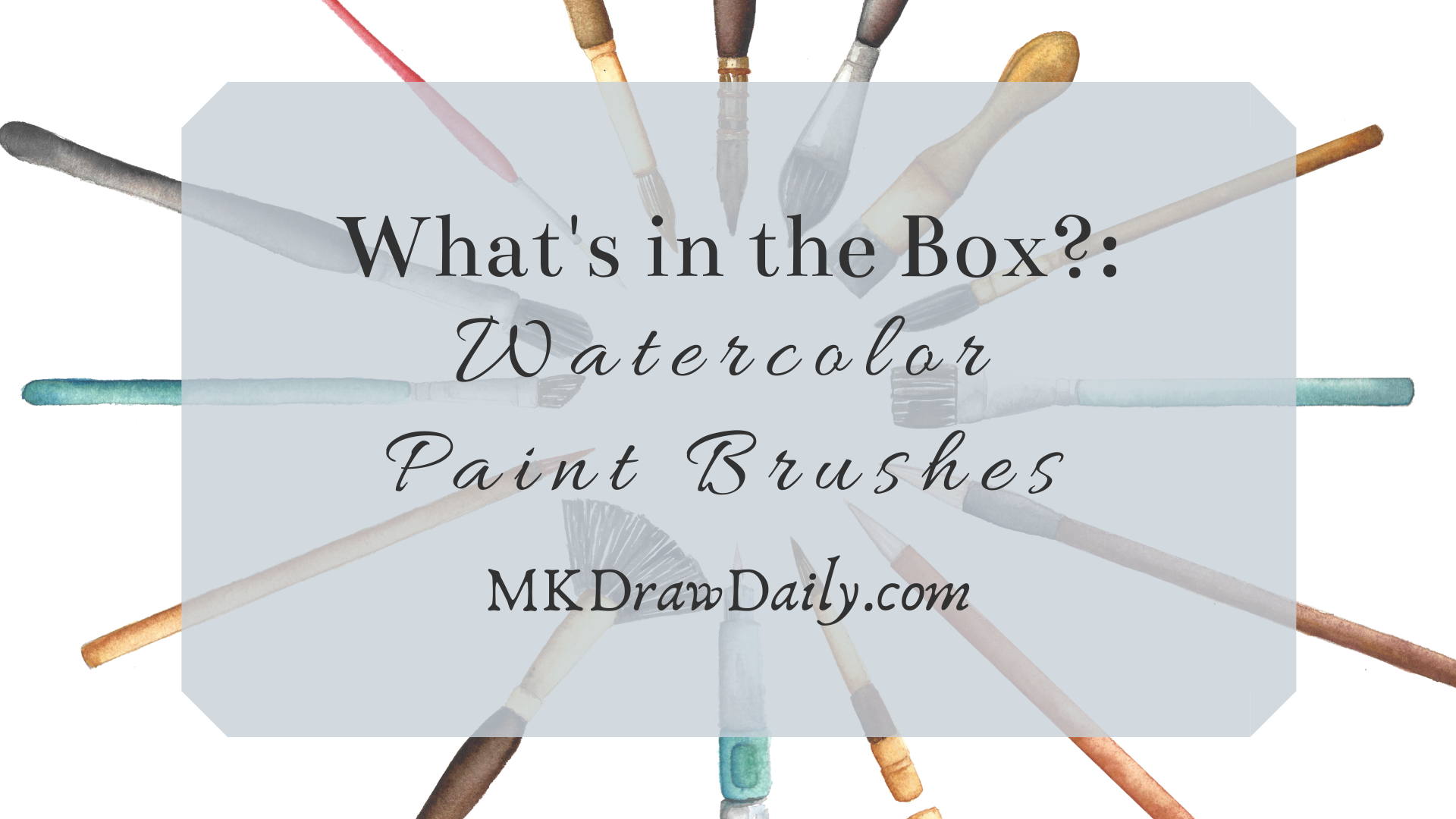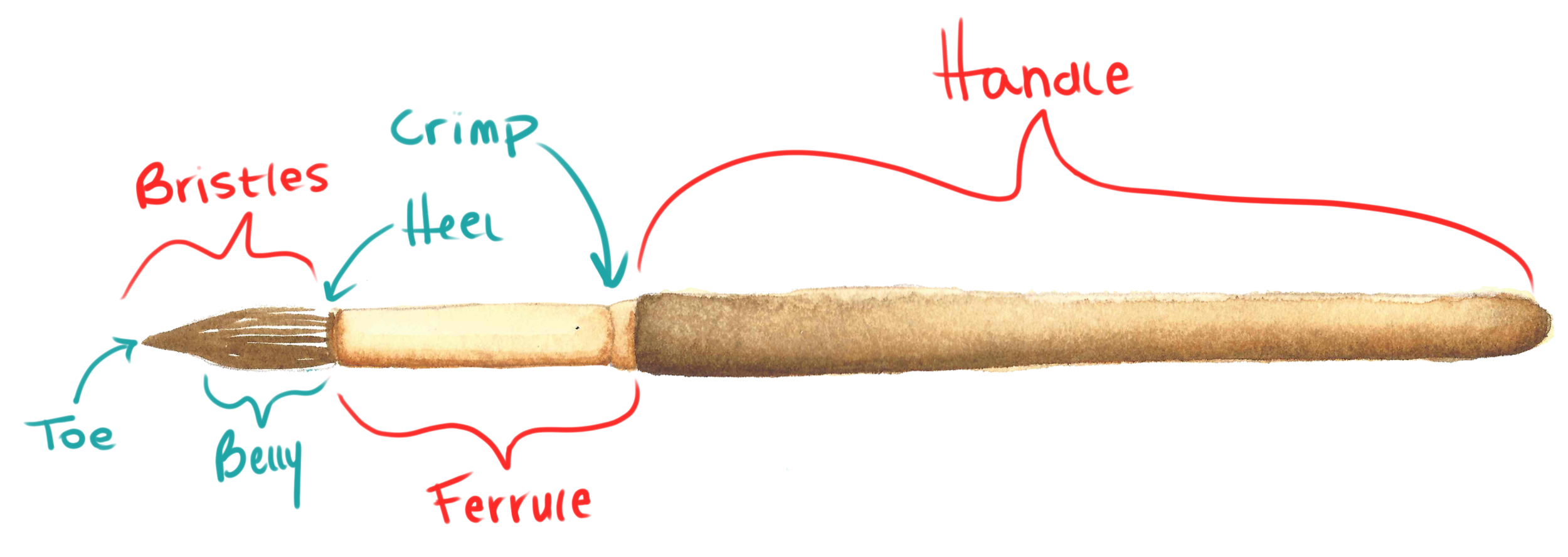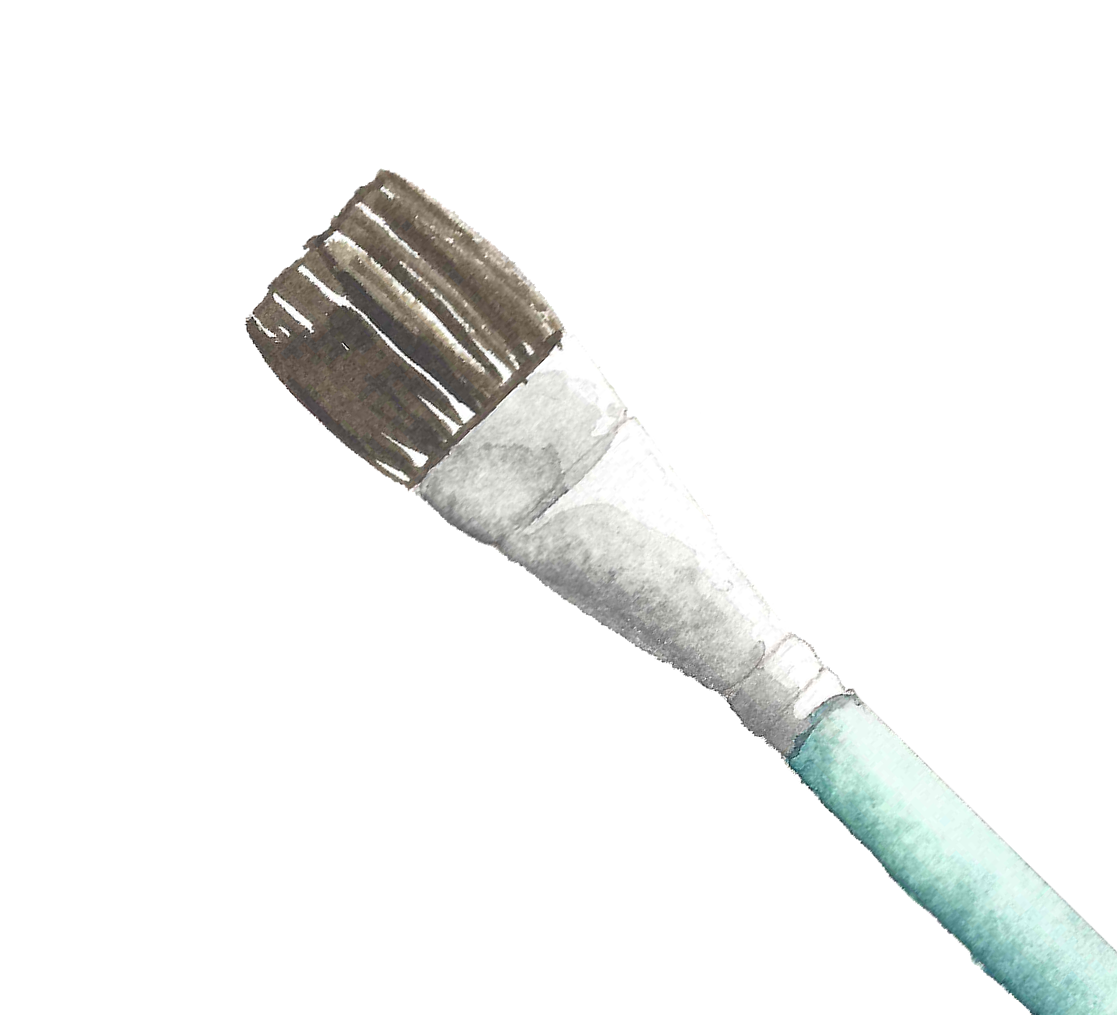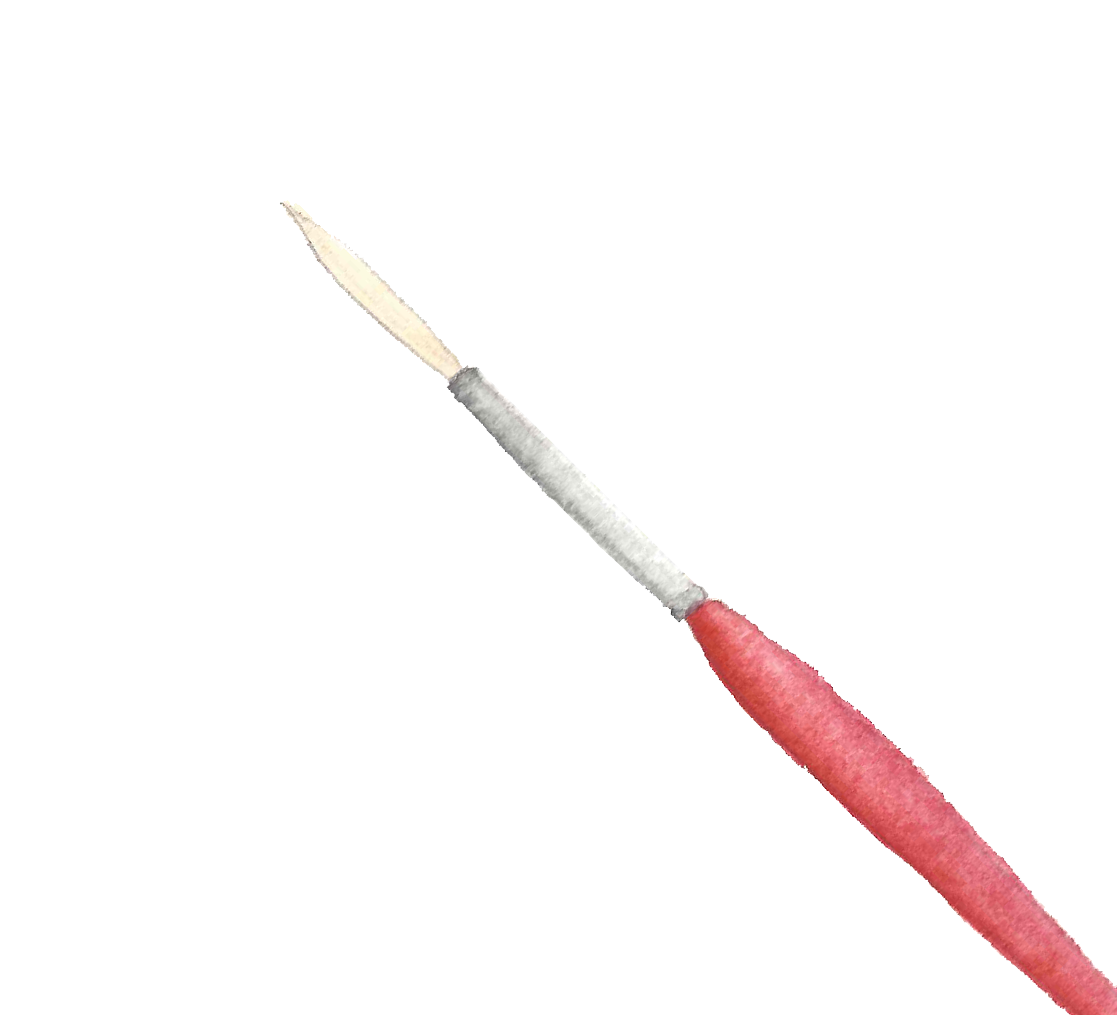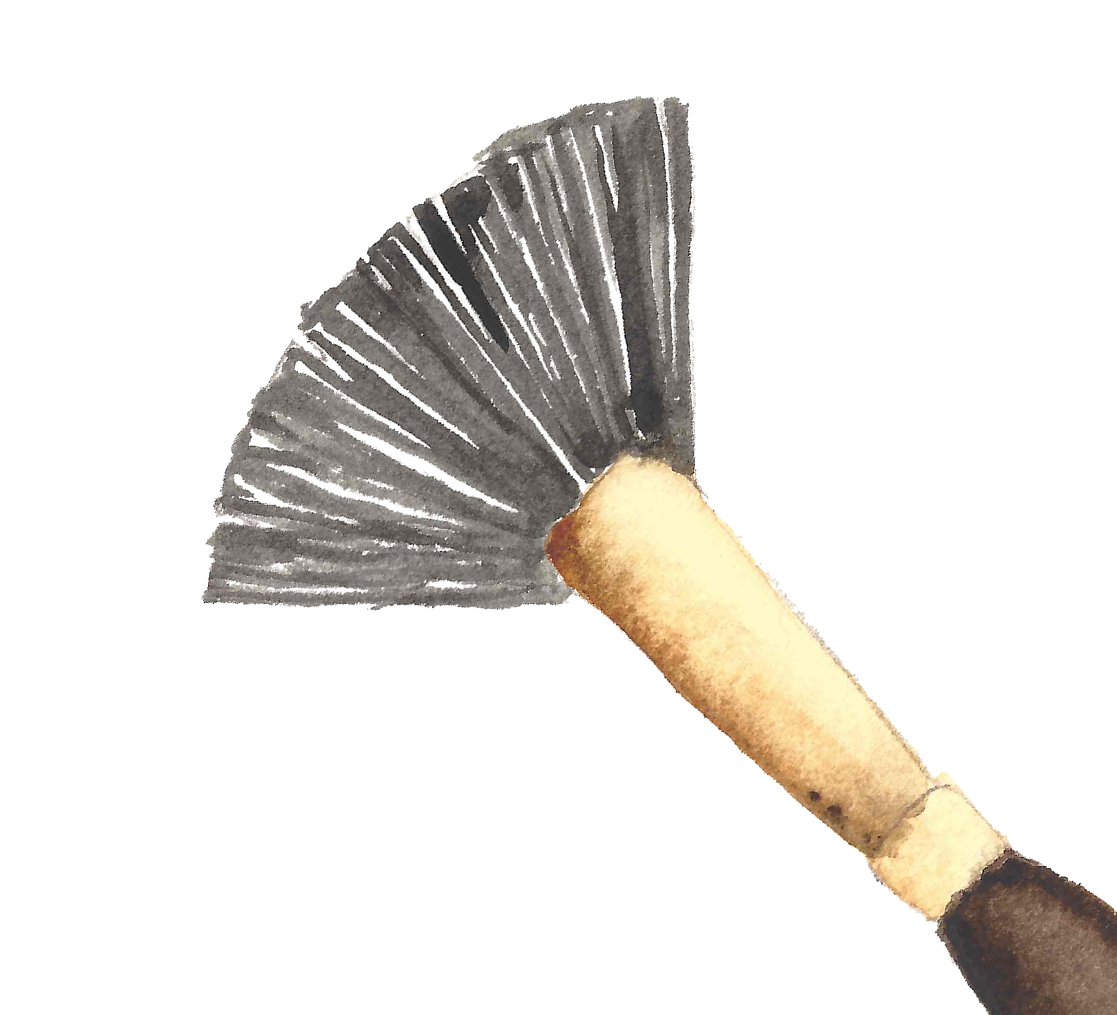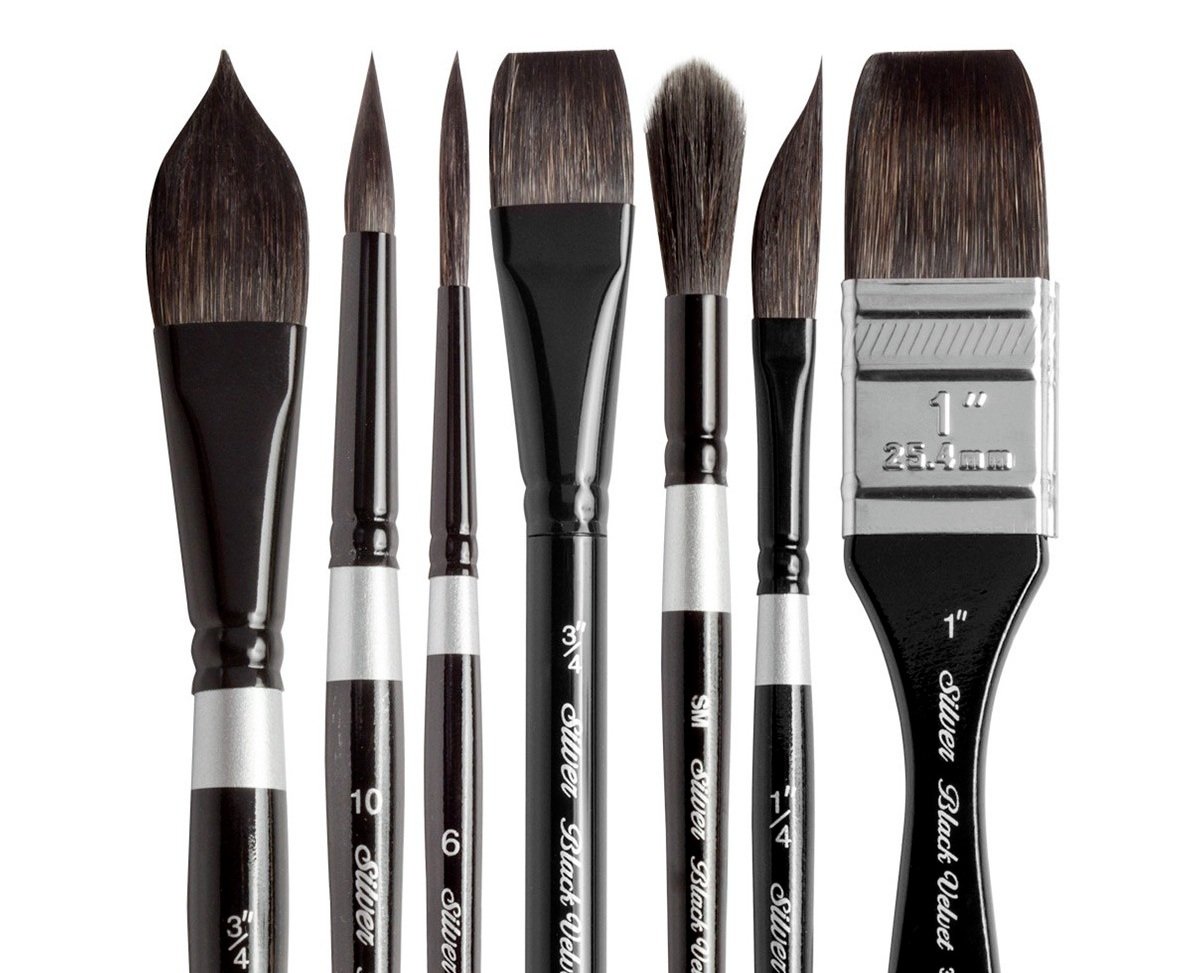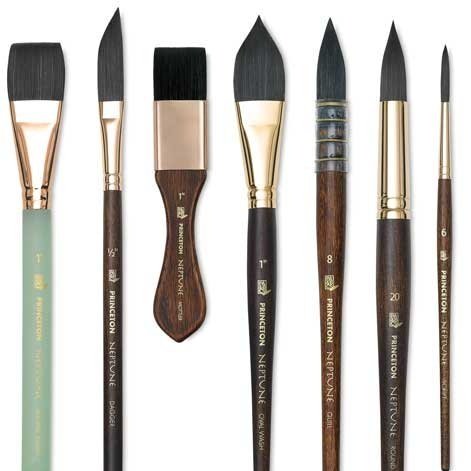What’s in the Box!? What You Need to Know About Watercolor Paint Brushes!
AN EASY GUIDE TO ESSENTIAL ART TOOLS
Paint Brush Anatomy | Paint Brush Types | Popular Brands | Paint Brush Tips
Welcome back to my official blog guide, “What’s in the Box!?”
And today we are going to approach the topic of watercolor paint brushes.
Today we will be discussing “Everything You Need to Know About Watercolor Paint Brushes” however, I have been told that some people find this presentation - meaning everything being in one place - overwhelming. So, you can choose to read on with everything right here, or you can follow one of the links above to jump to a different blog post where the information has been divided into parts.
Watercolor paint brushes are a special breed as watercolor paints have very different goals from other mediums. Mediums like Oil and Acrylic are thick, heavy bodied, and textural paints meaning that just as much personality comes from the texture of a painting, as it does from the colors, subject matter, and composition. This means that the paint brushes used for this type of medium have a few goals in mind. You need a brush that can handle a lot of paint, carry the paint from the palette to the canvas, and is sturdy enough to mold and move the paint onto and across the canvas.
Watercolor on the other hand is a delicate process which obviously requires a bit of a different approach. Watercolor paint brushes need to hold more than paint, they need to have a large belly to hold the water that the artist uses to dilute, move, and transfer the very limited amounts of actual paint that makes it onto the canvas. These paint brushes sport long, absorbent bristles that are known for their ability to hold a precise point, even the large brushes, which have the ability to retain their shape over time providing the artist a precision tool designed precisely for this medium.
PAINT BRUSH ANATOMY
Paint brushes are made of three individual pieces, the bristles - which are what carries the water and paint, the handle, and the ferrule - which is what connects the bristles to the handle. These three components can be made from a variety of different materials, depending on what your needs are, how much money you are willing to spend, and what your personal beliefs are; aka if you are vegan. I’ll just say this up front for anyone who might not know this, but most paint brushes are made with animal products or byproducts on some level or another, but there are vegan choices available, just keep reading, or jump to Popular Brands.
OTHER NEED-TO-KNOW AREAS
As you might have gathered from the image, there are a few areas other than just the bristles, handle, and ferrule that would be useful to know. As far as the bristle area we have another 3 vocabulary words that may prove useful while learning and exploring the watercolor art world.
The Toe
The very tip of the brush or the area that is going to be doing most of the painting and most often making contact with your canvas is called the toe. This is also the area that is expected to hold a sharp point and needs the most care throughout the whole painting and cleaning process.
The Belly
The belly of a watercolor paint brush is arguably one of the more important features designed especially for the watercolor medium. Many types of mediums don’t rely on the paint brush being able to absorb paint rather they are designed to either scoop up or drag paint across the canvas. Alternatively watercolor paint brushes do require not only the ability to hold large amounts of water and similarly drag the paint across the page, but these bellies are also designed to distribute its contents evenly across large areas of paper without expelling its load at either at the start or end of the brushstroke. At least this is what a belly is intended to do, inexpensive brushes may not hold to such a standard.
The Heel
The heel of a paintbrush is the area where the bristles and ferrule come in contact and is an important area of your paintbrush to pay attention to. You will want to avoid getting paint in this area of the paint brush, and if you do, it requires deep cleansing after use. The problem with gunk and paint getting stuck this far down can cause brushes to prematurely puff or fray making it hard for the paint brush to come to a sharp point. Before you cast a brush aside try giving this area of the brush a good washing and then see if it improves the brushes toe.
The Crimp
The last vocabulary word we will go over is the crimp, or the area of the ferrule that has been tightly restrained to the handle. This is so that the bristles and ferrule remain tightly secured to the handle helping to avoid a handles premature departure helping your paint brush live a longer, healthier life.
THE BRISTLES
So, there are basically three types of materials that the bristles of a paint brush can be made from. Those that are fully synthetic are made from man-made-materials such as nylon and polyester, then semi-synthetic are made from a blend of both synthetic and “natural” hair referring to animal hair, and fully “natural” brushes which are made exclusively from animal hair. The most popular being squirrel, goat, ox, and the top spot being reserved for sable. Some of the more common watercolor paint brushes however, are currently made from squirrel, or a mix of synthetic and squirrel, or synthetic-squirrel.
But sable are top quality, best in the business with prices sky rocketing into the hundreds of dollars depending on how big the brush is (and honestly they don’t actually need to be that big to come with a bigger price tag.) For example, a, what is known as a Kolinsky Sable (top of the top) by Princeton (top of the top and a valued manufacturer that I’ll talk more about in a moment), sell their size 10 round brush, which is about 8mm wide and is both a medium sized brush and a very common sized brush for a watercolorist to own, and they sell theirs for anywhere between $95 to about $150, depending where you pick one up. In contrast, the same sized paint brush, made by the same company but sporting a synthetic sable brush sells for between $10 - $19.
THE HANDLE
The handles for watercolor paint brushes are usually made from wood or plastic. Not quite as controversial, but the look and material can also depend on their price point. More inexpensive handles tend to be plastic or unfinished wood, but as you go up in price range you’ll usually see wooden handles are either stained or lacquered, some with curves meant to be more ergonomically designed so they bulge in the area intended to be handled.
You’ll find that there are few different designs, and when talking about watercolor in particular you are going to hear that many brushes are labeled as having ‘short handles’ and this has to do with the intimacy between you and your painting. Other mediums like oils and acrylics are better known for having ‘long handled’ paint brushes so that the artist can step away from their canvas by inches or even feet to have a better feel for the overall look of their work without getting too bogged down with the minutia. Watercolor on the other hand is intended to be more intimate and requires more of a personal touch and thus long handles would just be unnecessary and even awkward in the hands of a watercolor artist.
THE FERRULE
Most ferrules are made from metal and, on any paint brush worth its salt, is made from brass or copper because they are corrosion resistant. Paint brushes are exposed to a lot of water within their lifetime and you don’t want your paint brushes rusting out on you. More inexpensive choices might sport aluminum or tin, only because it is more inexpensive, but aren’t as resilient.
There are exceptions such as the quill brush, which I will expand on in just a moment, but there are other variations depending on where you are in the world. In East Asia they have traditional round paintbrushes made for ink paintings and calligraphy that sport variations on the ferrule which aren’t too different from what is more commonly used today, while others have a small ferrule, like the Princeton Bamboo paint brush, or no apparent ferrule at all as seen on some traditional Eastern Asia calligraphy brushes.
TYPES OF PAINT BRUSHES
As I said earlier, not all paint brushes are made equally, and this is even more so for the different types of watercolor paint brushes that are available on the market today.
THE ROUND BRUSH
The most common, most versatile, and most commonly used paint brush in the world is the round brush; and you’ve most likely used one at some point in your life already. The round is, historically, the oldest type of brush to exist and until the metal ferrule was invented during the Industrial Revolution between 1760 and 1840 it was the only type of paint brush. Of course they came in all different sizes and designs depending on what part of the world you live in, but this innovation, the metal ferrule, is a relatively new one (which is a pattern we have repeatedly seen in some of our previous topics regarding the watercolor medium).
In some ways this is the only paint brush you really need although it is very convenient to have some other options on hand and it is really a lot of fun to explore other options. If you are a new to painting this is where you should start. I suggest staring with a brush size of 10 or 12 in your collection as you can achieve both great detail with its fine point and has a belly large enough to cary a relatively decent amount of paint. You can branch out to other sizes and types of brushes as you get more comfortable with the medium.
Especially small round brushes can be referred to as detail brushes as they are used to achieve particularly small details in paintings, or even in other applications like figurine or toy car replications.
SQUARE WASH
The second most common and most used paint brush is the Flat Wash which came about during the Industrial Revolution as I mentioned a moment ago. This invention was one of the more substantial changes made to brushes at the time and is obviously the forefather to some of the other paint brushes here on this list. This is the second brush that I suggest you add to your collection, but the size you get can depend on what you are trying to achieve with it. A larger 1 inch brush is a good place to start for larger washes, but having a smaller one on hand for smaller details can be helpful as well.
In watercolors the flat wash helps to square off areas in your painting, to get straight edges, and allows you to easily get into corners. This brush is especially useful when filling in backgrounds while also providing long or straight edges to your painting’s borders. I use this type of brush extensively when working on architecture because of the texture and appearance it adds to the painting. It provides a way to lay in blocks of color neatly in a row; meaning I can quickly and easily lay in brick work, paint vinyl siding on houses, or wooden fences and barns. They are also very handy when swatching your paints to get a nice even appearance. Trust me, with this brush in your arsenal you’ll find dozens of excuses to pull this one out.
MOTTLER
Mottler Brushes are similar to the Flat Wash brush, but these ones are larger, roughly measuring anywhere between one-half and two inches depending on where and why you are looking to purchase one. They are usually relatively short handled brushes, even more so than the average watercolor paint brush. This type of brush can provide a wide range of uses in the art world, but because we are talking about watercolors, let’s be a little more specific.
A good Mottler is going to be an extremely thirsty brush (meaning it can hold a lot of water) which can just as easily lay down large amounts of water or paint. The artist can apply large and even washes for the purpose of backgrounds, gradients, or really any other reason you might need for laying down large amounts of water or paint over a large area of canvas. They can also be used to help sweep up dust and whatnot off your canvas or work area, but for this I would suggest you keep a cheap one on hand for this purpose alone.
OVAL
An oval is a unique brush and really is a hybrid of both a flat and a round brush, giving you the delicate point and large belly of the round, and the ground-covering abilities of a flat wash. This can be considered to be a ‘Jack-of-all-trades’ paint brush.
I personally like using this paint brush when a larger area needs to be covered and you need a little bit of help getting into or around other areas in your painting. An example of this is filling in a background but you need to protect a bunch intricate details you must paint around in order to do so. You won’t necessarily get as clean and crisp an edge as the flat wash, and the size you buy can depend on how large your paintings are, so you can get a smaller one if your paintings tend to be on the small side and vice versa.
Dagger
I believe that the dagger, sometimes called a sword, is probably the most interesting brush on this list in my opinion, but possibly one of the most unrecognized of the bunch. It has a strange name, a strange shape, and it can be hard to imagine exactly what a brush like this could be used for. But it may turn out to be one of your favorite brushes to play around with once you actually get one in your hand because of how versatile it is.
The dagger’s primary purpose tends to be one stroke applications of paint for leaves, flowers, and just foliage in general. Its unique shape allows artists to easily replicate these types of strokes with no real fuss and it really prefers to be handled in this way. But that is not to say it is the only purpose because you can manage all types of organic, natural looking, or random brush strokes just by changing the way you hold it in your hand. I would be here forever if I explained every type of organic shape or foliage it lends itself towards, so just know that it can basically achieve almost any foliage or organic shape you could image and it does it with the flick of the wrist.
QUILL
On the other hand we have the paint brush known as the quill which is also sometimes called a mop brush, but I do believe that there is a difference between the two. The ferrule used on the quill is based on the old styles ferrule used before the metal ones were more widely implemented during the 19th century. These are instead made from plastic or other durable materials that get wrapped around the brush and is secured onto the bristles and handle with wire. Quills tend to be quite large and this type of fastening can be much more secure compared to other methods and is thus required for a brush of this size.
Keep in mind that this is not your typical round brush. It is much longer, wider, and has a much larger belly. These have their own measuring system as they can be larger than even the largest of round brushes. The actual sizing of this brush can vary so your best bet is to figure out what size you want in millimeters before making your final choice and adding that brush to your cart. This is a very thirsty brush and is perfect for larger sections of canvas to be covered relatively quickly with relative ease. You can potentially switch out your larger rounds or oval brush for this one and vice versa.
As I mentioned this brush is sometimes considered to be interchangeable with what is called a mop brush, but I do believe that there is a bit of difference. A big difference is that mops usually sport a metal ferrule, unlike the quill, and usually doesn’t come to as fine a point as the quill. Their purpose is not to paint small details, but instead they help to easily and quickly cover large areas. If you want a large brush that does come to a point however, the quill or oval are preferable.
SCRIPT
Script liner brushes, also known as a rigger, or fine liner brush, can be mistaken for a round but one can usually tell the difference between them due to the fact that these are much longer compared to their measured widths. These are intended for a number of purposes such as long, evenly withed lines but are also useful for grass, hair, tree branches, and, as the name implies, it can also handle script writing or calligraphy. This brush is also commonly used to add the artists signature to their finished paintings. They are useful because they hold a lot more paint than a similarly sized round brush allowing you to cover more ground in a single stroke.
You can potentially replace similarly sized detail or round brushes with a script liner as they will be able to achieve the same goals as a small round brush, but holds a lot more paint than their smaller counter parts. Some artists may find this more convenient as it means you don’t have to make as many trips back over to your palette while you are working on your painting. These brushes are often described as being able to absorb the shake some people have in their hands so that it doesn’t reach the paper, allowing people to get straighter lines than what they might be able to achieve with a detail or small round brush.
ANGLE
Here we have a play on the flat wash brush which gives us a brush that is longer to one side of the ferrule than the other. The angled brush is also very similar to the dagger and can be described as a shorter more controlled version of it. Of course the major difference being the amount of paint this brush can hold compared to the dagger, which means that the angle brush is going to have less of a belly.
This brush has a razor sharp edge so you can pull very fine lines or small details with it such as leaves with thorny-points. It can lay down long edges more easily and is a bit sharper than the flat wash when using the blade and can help you get into corners that are smaller than a 90* angle. It can achieve similar brush strokes compared to the dagger but they aren’t as free or organic or random as the dagger, as you might call it, making this brush is a bit more controlled. Some people use this brush for calligraphy as well because you can get both extremely thin and wide lines from the same brush (wide lines can be achieved when the brush is pulled to the side) creating the perfect combination of both worlds.
FILBERT
The filbert can be described as a variation of the flat wash except that this has a scalloped edge, and is longer than your typical flat wash. This can also have a sharp edge and its use is usually to pull a very specific shape, like those associated with flower petals or other similarly shaped curved edges. You can get various brush strokes from this brush by manipulating the way you hold it in your hand by twisting and/or pulling the brush along the paper. Filberts are an exceptional tool for when you need to paint circular shapes as the curved edges allow the paint brush to be pulled in a circular motion without going outside of the lines like a flat wash would.
FAN
Fan brushes are relatively well known, although I think this is simply because of its unique shape but I don’t know that most artists would actually know what to do with one if they did get their hands on it. For watercolor, it doesn’t necessarily meet the typical qualifications you would expect from a paint brush such as the capacity to hold a lot of water, there is not much belly to this brush so it runs out of paint rather quickly.
You can use this to your advantage however, by using it as a dry brush to get scattered textures. It can also be used to draw hair, grass, water, wood, and any other textures that might require either spaced out marks, or dry brush effects. Using it side to side can create some great ground textures, but you can also use it for tree leaves and tree trunk textures. You can also use this kind of brush for softening edges and to help blend them out.
TRAVEL
Travel brushes, also known as reversible, collapsable, or pocket brushes are really fun and interesting due to their unique design. These brushes are usually made of metal, some are partly made of plastic, and some do sport a bit of wood along the handle just below the ferrule.
They have a cap that goes over the bristles to protect them while in storage which helps to keep the bristles safe while they are banging around in your art bag. The fun part is that these covers can be turned around and attached to the bottom of the brush to extend it out further making it more comfortable to hold in your hand. The only thing to be said about this sort of brush is that it can be hard to find one that isn’t a round, although they do exist.
WATER BRUSH
Water brushes or brush pens are also are a type of travel brush and the difference being that they hold water in the body of the paint brush, so that it is easier to make art and paint while on the go. With the water in the body of the paint brush, it removes the need of a water cup which is much more convenient while on an air plane or train. It can be hard to find a convenient way to transport water and putting it in the handle of your brush saves space and time.
These paintbrush bristles are pretty much exclusively made from basic synthetic plastic materials, with no attempt to doup or replace a natural bristle. These paint brushes are usually inexpensive, and can differ greatly from brand to brand, so it is best that you try out a few styles to see what works best for you.
Silver is a brand that started in NY in 1991 trying to bring quality artist paint brushes into the US. Since then they have developed various lines of brushes for oil, acrylic, watercolor, and mixed media.
They are best known for their Black Velvet line which are made from a mix of synthetic and natural squirrel hair and sell round, oval, script, square wash, dagger or striper, and a selection of round travel brushes. You can also find their line of quill brushes which are made from the same combination of both synthetic and natural hairs.
A blend of natural squirrel hair and black synthetic filament combines to provide excellent carrying capacity with control, spring, and precise pointing. Black Velvet brushes are full bodied, with a wonderful snap. Use them with watercolor, silk painting, inks, dyes, acrylics, and gouache.
A polished black ferrule crimps the hair and is fitted to a gloss black handle. Enjoy a wonderful range of styles and sizes.
PRINCETON
Princeton Artist Brush Co. started in Princeton, New Jersey in the 90’s, and sell a wide range of vegan artists brushes including oil, acrylic, watercolor, mixed media, and a variety of specialty brushes. This company started with the goal of creating the finest synthetic sable in the industry and ended up with their Aqua Elite Series 4850 which sport a synthetic Kolinsky Sable. This line includes angle, dagger, fan, liner, round, mop, mottler, oval, quill, rigger, round, travel, and square wash brushes.
Princeton Aqua Elite Series 4850 Brushes feature Princeton's NextGen synthetic fibers that are almost indistinguishable from natural Kolinsky in appearance, performance, and durability — at a more affordable price.
Qualities of these brushes include maximum color-holding ability, excellent shape retention, fine points and tapered edges for precise details, and comfortable handles for lengthy painting sessions.
PRINCETON
However, their arguably best known line of brushes, and my personal favorite, are their Neptune paint brushes which sport their unique and groundbreaking fully synthetic squirrel hair. They even claim that their synthetic squirrel out performs the natural version. On their list of brushes that they sell: square wash, dagger, mottler, oval, quill, round, script, and travel brushes.
When Princeton set out to create a synthetic version of Squirrel, the company developed a brush that may actually outperform the natural version.
Neptune is Princeton's thirstiest brush ever, delivering oceans of color to the sheet. Featuring the latest synthetic fiber technology, the Neptune's multiple-diameter filaments are configured to replicate the smooth feel of natural Squirrel, with enhanced snap and resilient strength. Experts in natural hair have been incredulous that the Neptune brush fibers are actually synthetic.
Princeton is proud to offer Neptune in a beautiful range of shapes that includes hand-tied Mottlers and Quills. The beautiful sea glass handles of the Aquarelle brushes are the signature of the line.
ROSEMARY&CO.
Rosemary&Co is based in England and started over 35 years ago by Rosemary who has dedicated her life to manufacturing artist quality brushes. Rosemary&Co have the largest range of travel brushes that I’ve been able to find selling oval, round, mop, square (or flat), dagger, and quill, among others. Unfortunately, at the time of writing this not all products are available to ship to the US, as the US currently has bans on certain products so do keep this in mind, but I still wanted to share this brand with you due to their large collection.
Rosemary & Co have a wide range of watercolour brushes available. We have a selection of natural hair watercolour brushes and synthetic watercolour brushes. Our most popular range for watercolourists are our Pure Kolinsky Sable brushes.This range is made from the finest quality Kolinsky Sable Hair. There is no doubt Kolinsky Sable is the favoured choice for many professional watercolourists as this hair tapers to a finer point, holds the most pigment and wears down well.
Our Pure Red Sable range are also a great choice for watercolour painting, a pleseant extra to your watercolour brush arsenal. The Pure Red Sable hair also taper well, wear down well and have a good snap, but nevertheless will always be a great second place to the Kolisnky Sable Hair. Truthfully, it's not until you try the two brush ranges side-by-side that you will feel the luxury of using a Kolinsky Sable Brush.
PENTEL
Pentel is a very successful writing and art supply manufacturer who have been around for over 70 years, but are best well known for their writing utensils. Once in a while they produce a product that shakes up the art industry standards and their Aquash Water Brush has become one of the more popular brands today.
Ideal for sketching and drawing, the Pentel Arts Aquash Water Brush has a durable nylon tip that holds its point for better stroke control. Available in a variety of tip sizes, this versatile brush loads easily with water, inks, or fluid colors. What's more, the soft, easy-to-squeeze barrel has a shape that prevents it from rolling off surfaces.When filled with water, the Aquash Water Brush is great for use with pocket watercolor sets when painting plein air.
GRACE ART
There isn’t a lot of information available for these brushes, but they are a very cheap alternative that work wonderfully for what they are, and are honestly all you need if you don’t want to invest in more expensive brushes. In total it offers a set of 12 brushes: 6 rounds and 6 flats in sizes: 2, 4, 6, 8, 10, and 12. As far as I can tell they are only available on Amazon.com.
10 WATERCOLOR PAINT BRUSH TIPS
YOU SHOULD KNOW BEFORE USING WATERCOLOR PAINT BRUSHES!
YOU DON’T NEED EVERY BRUSH
I think that it might be important to discuss the fact that you don’t need every brush just because they exist, or because you have seen someone using an interesting or unique brush. In fact, I recommend that you have as few brushes as possible because many of these paint brushes, their purposes, and what they can accomplish often overlap with other paint brushes. So, instead, take stock of what your goals usually are when you are painting, and adjust your brush collection so you have what you need. This also helps cut the cost of your supplies, especially if you are already on a tight budget.
If you still aren’t sure, I suggest you start with a moderately sized round, maybe a 10, and a decently sized flat wash brush, something that is about 1/2 inch should do fine at first. Start with these two brushes and as you work with them more and more, you may find where the gaps in your collection are and you can make choices based on that. Always keep in mind, however, that you can achieve most techniques with a good round brush.
RINSE YOUR NEW BRUSHES
Brand new watercolor paint brushes always come with a bit of ‘stuff’ on the bristles - there are a few different materials that manufacturers might use, such as a gentle water-soluble glue or a bit of gum arabic for example - but this stuff helps the paint brush keep and maintain its shape while on the shelf or while being transported as they patiently wait to find their forever home. This means that before you get to paint, you’ll want to give your brush a good rinse under warm water first. Use your fingers to gently massage the bristles free from that ‘stuff’ until the bristles are no longer sticky or hard and are ‘squeaky clean’ meaning they should feel squeaky clean!
AVOID WATER
This might sound funny, but your paint brushes are designed to only handle a certain amount of water during its lifetime and the dryer you can keep your brushes the longer they will last. There are two major scenarios that you will want to avoid. The first is, when you are done with your paint brushes and they have been thoroughly rinsed, do not stand your brush up vertically to dry. The water will seep into the ferrule which can lead to damage and bristle fallout over time.
The Second scenario is to never let your paint brushes sit in your water-cup for any length of time. There are actually a few reasons why this is damaging.
Your bristles will be under stress sitting at the bottom of your cup which can bend and change the shape of the bristles ultimately leading to damage and fraying that can prevent the brush from coming to a fine point. This damage can’t always come undone.
The ferrule of the paint brush will most likely be submerged in the water when sitting in the cup, which can lead to the softening of the glue and binders holding the bristles in place leading to fallout damage and it may become unusable.
In addition to bristle and ferrule damage, leaving the handle submerged for any length of time will end with the porous wood absorbing that water, causing the handle to break and fall apart. If there is a fancy lacquer on your handle, it will break up and fall off as the wood expands. This certainly can not be undone.
WASH SHAPE AND AIR DRY
When we are in the moment and completely preoccupied by our thoughts while painting, we can become careless with our paintbrushes and we can do things that might not be in their best interest. This means that once we are done with our painting session we may want to treat our brushes to a bit of a spa day. During this process you:
Rinse your brush with a bit of warm water similarly to how we cleaned our brushes earlier. Simply massage the bristles until the water runs clean. Take care to rinse and clean as close to the ferrule as you can, leaving behind paint near the ferrule can prevent your brushes from coming to a fine point when re-wetted.
You may be inclined to wash your paintbrush with a cleanser. This is fine, but avoid shampoo as it can dry out your bristles leading to fraying. Instead you will want to use a brush cleanser. When applying this you’ll want to roll your round brushes, and carefully swipe your flats without bending or deforming the brushes as this can lead to damage over time.
You can let your brushes sit for a moment, especially if your cleanser is also a conditioning formula. Once you are ready you can rinse the brush clean again same as before.
Lastly you will want to return the bristles back into their intended shape which will also help them them live longer lives. You don’t need to do this with your fingers, simply flicking the brush with your wrist should bring it to a fine point.
DRY BRUSHES
Just because your good brushes do not come to a point when dry doesn’t mean that your brushes are damaged or unusable. The only way to truly test if a brush is damaged or frayed is by rewetting them throughly. Once wet, if they come to a point, they are just fine. If instead they struggle to come to a point, all might not be lost - but if a simple wash shape and dry doesn’t do it, you can try out this next trick:
DAMAGED BRISTLES
If you find that your paint brush bristles have acquired a bit of fraying, have taken on an odd shape, or won’t come to a point - you can try washing and shaping your brush with some brush cleanser. But instead of rinsing the brush out, you can leave the cleanser and conditioner on let the brush dry and sit that way for some time until you are ready to use the brush again. Simply rinse the brush throughly when you are ready and hopefully it will come to a fine point once again.
DON’T TRIM YOUR BRUSHES
Sometimes we get a little desperate when our favorite brushes get damaged and attempt some at-home surgery to get it back into fighting shape. This means we might pull out some scissors to try and tame the wilderness that has grown over the landscape and you feel compelled to perhaps trim away some of the problem areas. This is a big hell-no move especially if you are using natural brushes because each individual bristle is going to have a particular shape - thicker towards the heel or ferrule end, and taper to a thin point towards the toe or point of the bristle. This means that if you start trimming, you are trimming away the area that allows the brush to come to a point, and, in the end, you are doing more damage than good. You may just have to bite the bullet and replace it.
ONLY USE WATERCOLOR PAINT BRUSHES
It can be hard for us not to opt for picking up a few cheap brushes rather than spending a little more for basically the “same thing”; I mean they say ‘watercolor’ on the label! Sure it may also say that it’s great for acrylic and oil but what harm can it ultimately do? Well, let’s look at it this way: Is it a cheap synthetic without much of a belly? Does it have a hard time keeping its shape even when wet? It’s these little things that start to add up when you are buying the wrong materials for the job you want them to take on. Without a belly to hold water, you’ll basically be applying a ‘dry brush’ to your canvas, and without a fine point you won’t be able to achieve much detail. Too much compromise one way or the other can lead to problems that could have been easily avoided just by getting the right tools the first time.
If you aren’t sure what a particular brush will be able to handle, you do have the option of trying those brushes out at the art store. Employees at art stores will understand if you ask them for some water and will allow you to check out and play with the merchandise before you make your purchase. Buying the right brush is important, so don’t waste your money and buy the right brush, all you have to do is just ask for water!
AVOID NON WATER SOLUBLE PRODUCTS
It can be very tempting sometimes to dip our brushes into something other than watercolor paints, but we have to fight the urge with all our being. Especially when dealing with materials that aren’t water soluble. Things like acrylic paints and masking fluid will dry out on your brush - which happens rapidly - and will prove to be impossible to remove at that point. Not to mention the potential damage substances like these would ultimately cause to your soft and delicate watercolor bristles. You are better off using a brush intended for the job you want it to preform and save your watercolor brushes from total disaster and an early grave.
If you do need a brush to apply masking fluid there are two preventative measures you can take to help avoid your brushes from ending up a landfill.
Use an older or damaged brush if possible that is more up to the job, or something like a fully synthetic brush which is a bit sturdier, but also…
Gently roll and lather your paint brush with soap before dipping into your masking fluid. This will prevent the masking fluid from attaching and drying on your brush allowing the masking fluid to be easily washed away with a bit of water.
DON’T HOP MEDIUMS
So despite my caution, you may still end up with a brush that is capable of crossing mediums - it happens, and there are some really great brushes out there that are more than capable of it. If you happen to have one of these rare birds, it’s important that you don’t use that particular brush with multiple mediums. Leave your watercolor brushes to only mingle with your watercolors, and provide your other medium with their own set of brushes. This might seem wasteful or inconvenient having to buy new brushes when starting with a new medium, but it will help your brushes in the long run to live longer, fuller lives.
Let’s look at an easy example: if you are already painting with watercolors and feel like trying out oil paints, the worst thing you can do to your watercolor paintbrushes is to start dipping them in oils. You’ll likely be filling up your brush with not only oil paints but also linseed oil or another medium which, quite frankly repels water. Now, your watercolor paint brushes might actually fight against your water and paints, making them completely useless for watercolor painting. Your better off getting a brand new set of brushes for your newfound oil paints.
That’s it for today, thanks for reading!
I’m MK and this is Draw Daily!
